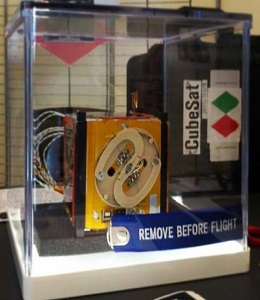
Vega is an expendable launch system in use by Arianespace jointly developed by the Italian Space Agency (ASI) and the European Space Agency (ESA). Development began in 1998 and the first launch took place from the Guiana Space Centre on 13 February 2012.

A CubeSat is a class of small satellite with a form factor of 10 cm (3.9 in) cubes. CubeSats have a mass of no more than 2 kg (4.4 lb) per unit, and often use commercial off-the-shelf (COTS) components for their electronics and structure. CubeSats are deployed into orbit from the International Space Station, or launched as secondary payloads on a launch vehicle. As of December 2023, more than 2,300 CubeSats have been launched.

The Romanian Space Agency is a public institution that coordinates Romania's national space technology research programs and activities related to space research. ROSA, established in 1991, is subordinate to the Romanian Ministry of Education.

Soil Moisture Active Passive (SMAP) is a NASA environmental monitoring satellite that measures soil moisture across the planet. It is designed to collect a global 'snapshot' of soil moisture every 2 to 3 days. With this frequency, changes from specific storms can be measured while also assessing impacts across seasons of the year. SMAP was launched on 31 January 2015. It was one of the first Earth observation satellites developed by NASA in response to the National Research Council's Decadal Survey.

SARAL is a cooperative altimetry technology mission of Indian Space Research Organisation (ISRO) and Centre National d'Études Spatiales (CNES). SARAL performs altimetric measurements designed to study ocean circulation and sea surface elevation.

LARES is a passive satellite system of the Italian Space Agency.

SwissCube-1 is a Swiss satellite operated by École Polytechnique Fédérale de Lausanne (EPFL). The spacecraft is a single unit CubeSat, which was designed to conduct research into nightglow within the Earth's atmosphere, and to develop technology for future spacecraft. It has also been used for amateur radio. It was the first Swiss satellite to be launched.

A number of space tethers have been deployed in space missions. Tether satellites can be used for various purposes including research into tether propulsion, tidal stabilisation and orbital plasma dynamics.

Colorado Student Space Weather Experiment (CSSWE) was the sixth National Science Foundation sponsored CubeSat mission. It was built by students at the University of Colorado at Boulder with advising from professionals at the Laboratory for Atmospheric and Space Physics. The CSSWE mission was a joint effort by the University of Colorado's Department of Aerospace Engineering Sciences and Laboratory for Atmospheric and Space Physics. The mission principal investigator was Prof. Xinlin Li, and the Co-PIs are Prof. Scott Palo and Dr. Shri Kanekal. The project manager for the project was Dr. Lauren Blum, the system engineer was Dr. David Gerhardt, and the instrument scientist was Dr. Quintin Schiller.
PW-Sat is a series of Polish CubeSats designed and built by students at the Warsaw University of Technology in conjunction with the Faculty of Power and Aeronautical Engineering of Warsaw University of Technology, the Space Research Centre of Polish Academy of Sciences, and the European Space Agency. As of January 1, 2024, there have been 2 PW-Sats with a third in development. The first PW-Sat was the first Polish artificial satellite which was launched 13 February 2012 from ELA-1 at Guiana Space Centre aboard Italian-built Vega launch vehicle during its maiden voyage. After their graduation, the team that developed the original PW-Sat have also worked to develop the subsequent missions, establishing a private company named PW-Sat to design and manufacturer the PW-Sats, all of which test novel deorbiting methods, with the overall goal of the program to develop solutions to space debris.

e-st@r was a miniaturised satellite built by the Politecnico di Torino. It was a 1U CubeSat design with a 10 cm side and a mass not exceeding 1.33 kg.
UniCubeSat-GG is a Miniaturized satellite built by the Sapienza University of Rome. It was launched into Low Earth Orbit on the maiden flight of Arianespace's Vega rocket on 13 February 2012. The launch was a multi-payload mission shared with LARES, ALMASat-1, Goliat, MaSat-1, PW-Sat, ROBUSTA, e-st@r and Xatcobeo.

ESTCube-1 is the first Estonian satellite and first satellite in the world to attempt to use an electric solar wind sail (E-sail). It was launched on 7 May 2013 aboard Vega VV02 carrier rocket and successfully deployed into orbit. The CubeSat standard for nanosatellites was followed during the engineering of ESTCube-1, resulting in a 10×10×11.35 cm cube, with a volume of 1 liter and a mass of 1.048 kg.
Biomass is an Earth observing satellite planned for launch by the European Space Agency (ESA) in 2024 on a Vega launch vehicle.

Vega flight VV01 is the maiden flight of the Vega launcher. It occurred from the Centre Spatial Guyanais (CSG) on 13 February 2012 at 10:00:00 UTC.
ION Satellite Carrier is a satellite platform developed, manufactured, and operated by Italian company D-Orbit. The platform features a customizable 64U satellite dispenser capable of hosting a combination of CubeSats that fits the volume. Throughout a mission, ION Satellite Carrier can release the hosted satellites individually, changing orbital parameter between one deployment and the next. Each of the miniature CubeSats weighs a few kilograms.

Simulation-to-Flight 1 (STF-1) is a microsatellite built by the Katherine Johnson Independent Verification and Validation Facility (IV&V) in Fairmont, West Virginia with the collaboration of the West Virginia Space Grants Consortium and West Virginia University.

Orbiting Vehicle 2-5, the third and last satellite of the second series of the United States Air Force's Orbiting Vehicle program, was an American particle science and ionosphere research satellite. Launched 26 September 1968 along with three other satellites, OV2-5 became the first scientific satellite to operate at geosynchronous altitude.

Hera is a space mission in development at the European Space Agency in its Space Safety program. Its primary objective is to study the Didymos binary asteroid system that was impacted by DART and contribute to validation of the kinetic impact method to deviate a near-Earth asteroid in a colliding trajectory with Earth. It will measure the size and the morphology of the crater created by and momentum transferred by an artificial projectile impacting an asteroid, which will allow measuring the efficiency of the deflection produced by the impact. It will also analyze the expanding debris cloud caused by the impact.














